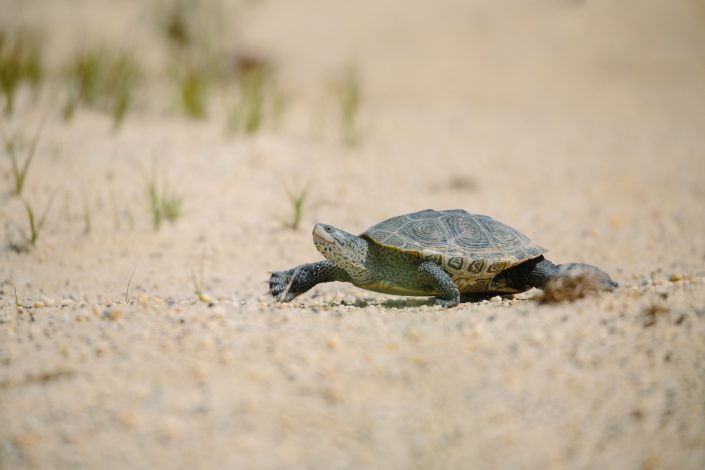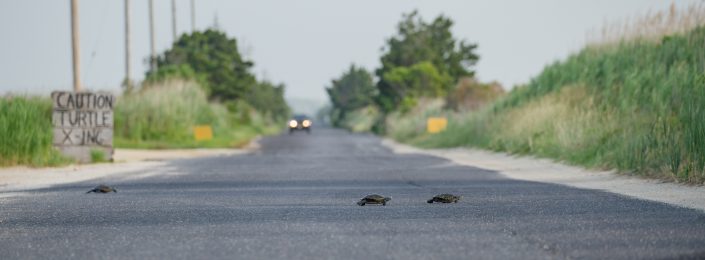Build it and they will come
by Ben Wurst, Habitat Program Manager

As with many of our conservation projects, they are centered around compassion for a species in need. One of which is the northern diamondback terrapin: a coast hugging turtle who inhabits salt marsh habitat from Cape Cod to Cape Hatteras. In New Jersey they range from the Meadowlands south along the coast and in the Delaware Bay. Terrapins are known to have a very small home ranges and some may inhabit the same small creek for their entire lives. During summer months, females leave the protection of their salt marsh habitat to seek out sandy nest sites above the high tide line. Many times, they encounter a roadway and the results can be deadly.

Our work with terrapins began in 2010 after personally witnessing large numbers of adult roadkills on Great Bay Blvd. (also known as Seven Bridges Road) in Little Egg Harbor. It is a 5 mile long road which bisects 5,500 acres of intertidal salt marsh habitat, home to many terrapins. Past research highlighted the concern of sex-specific road mortality of adult females on Great Bay Blvd, so we founded the Great Bay Terrapin Project to document and reduce roadkills.
Each summer we recruit volunteers (including student interns) to conduct surveys on roads in southern Ocean County to document the presence of terrapins. They take action to reduce roadkills while also engaging with the public, to raise awareness for them. Our student interns conduct more thorough surveys on Great Bay Blvd. and besides recording the location of each terrapin they encounter, they also measure, weigh and mark them for future recapture and identification.




Last year the first big wave of terrapin nesting season coincided with the new moon in June. Many adults were observed in breeding aggregations near known nesting areas, which is a magical phenomenon to witness! During this time of year, there are often more terrapins than cars on the road (and that is a good thing).

A total of 525 terrapins were documented from June to mid-July. Of those 49 were found injured or dead on road. Our interns encountered 227 terrapins, with the majority being unmarked. The average carapace length, width and height was 183.4mm, 136.6mm, and 73mm. The average plastron length was 160mm. The average weight was 963 grams. 68% were gravid at the time of capture. The smallest female encountered was 135mm and weighed 421g and the largest was 205mm and weighed 1558g. The age can be determined in some adults by counting their annuli or growth rings on the plates (scutes) of their carapace (back shell). The average age of adults was 10.

The oldest adult encountered was IJPQX, at 19 years old. She was a new recapture who was seven years old when marked on June 16, 2009 on GBB by Claire Sheridan/Drexel University. Amazing to see terrapins living long lives with so many threats. A notable finding by our interns included 38 terrapins who showed signs of a previous injury by boat, which are deformities in the carapace and/or plastron (some healed and not) and broken/missing limbs.
To help turn the tide and provide more suitable habitat for terrapins to thrive, we partnered with NJ Division of Fish & Wildlife to create a large “turtle garden” for females to nest. The 1/2 acre garden was established in late 2019, in the parking lot of a former marina along Great Bay Blvd. Since then it has provided optimal habitat for females to nest and lay eggs.






It takes a keen eye to locate a terrapin nest. After depositing up to 18 eggs in a nest cavity, females leave little evidence of their presence to protect their young, who receive no parental care. This year close to 200 nests were found in our turtle garden. The majority (152) were protected with a metal cage to ward off predatory birds (fish crows and gulls) and mammals (raccoons and foxes). Once the eggs incubated for around 75 days, young began to hatch and were allowed to leave the protection of their nests on their own. Towards the tail end of the hatchling emergence period, we conducted nest checks with our volunteers to determine outcomes and around 100% of nests protected with cages hatched successfully. Those that were not protected with cages were more vulnerable to predation.







We are grateful for the contributions of our project volunteers, especially several new ones this year, who really helped make this project a success! From conducting road patrols and monitoring the turtle garden to making predator cages and entering data — their support is greatly appreciated!
Thank you to all CWF members, project volunteers, partners, and donors including Absolutely Fish, Zoological Society of New Jersey, and the Osprey Foundation for supporting our work! A portion of the funding for the Great Bay Terrapin Habitat Enhancement Project was supplied by Forked River Power LLC through a NJDEP Supplemental Environmental Project which CWF obtained in 2019.
- Read our year end report
- Become a volunteer!
- College students! >> Apply for our 2022 Great Bay Terrapin Project Internship!
- Learn more about Great Bay Terrapin Project
Discover more from Conserve Wildlife Foundation of NJ
Subscribe to get the latest posts sent to your email.
Leave a Comment
Fabulous!!! What a great idea to build a “turtle garden”!! As “turtle foster parents” a few decades ago, we are always excited to see efforts on behalf of these ancient and wonderful creatures, especially the endangered ones! The hand full of hatchlings reminds me of the two clutches of common snappers on our property beside the Millstone River during the 80s. The bigger mom produced 44, the smaller 24, but both were successful, and we protected them from predation then “ushered” the little ones into the river after they emerged.
L@@king forward to another great season at the garden!
Comments are closed.